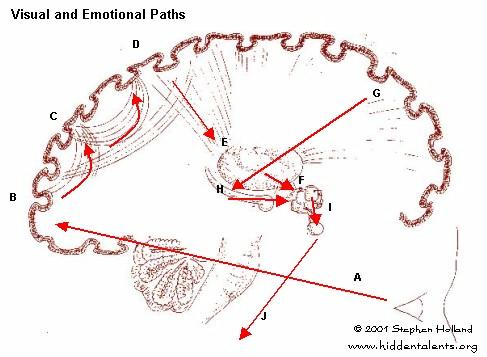
Hidden Talents and Brain Maps
Hiddentalents.org
© 2001 Stephen Holland --- sholland@softwaves.net
| 2 Input | 4 Quilt |
 Hidden Talents and Brain Maps Hiddentalents.org © 2001 Stephen Holland --- sholland@softwaves.net
|
Home | Index | Outer parts | |||||
| Input / Output | Inner parts | |||||||
| L / R Sides | Patchwork Quilt | |||||||
| Brain Maps | Print maps | |||||||
| LEFT Brain | RIGHT Brain | |||||||
| Activities | L / R Types | |||||||
| Balanced vs Expert | Men vs Women | |||||||
| Feedback | Sources | |||||||
|
|
||||||||
| 3. Inner Parts of the Brain |
| (1) The Cortex is a layer about the thickness of an orange
peel, and is the actual area where most "thinking"
takes place. The cortex has many specialized
patches. It can be also thought of as the
"unconscious mind" because most
patches of the cortex work automatically.
For example, your sensory areas work 24 hours
a day, monitoring incoming sounds and skin
signals (your vision areas don't get signals
at night, so use dreams to keep active). (2) Association fibers carry information from one patch of the cortex to another. The vision patch(A) will process what comes from the eye to see lines and shapes, then pass it on to patch (B) which determines distance and motion, and thence to patch (C) which is designed to recognize objects.  (3) The Thalamus is the master control center of the brain. It acts a Chief Executive Officer or CEO of the brain, monitoring all senses and actions. (4) The Limbic System is important to memory. For example, it can add "emotional tags" of "danger" to memories of snakes. (5) The Hypothalamus is the master center for emotions and instincts, such as hunger, thirst, pleasure and anger, and it also regulates body temperature. (6) The Pituitary Gland translates nerve signals into chemical signals. Fear emotions in the hypothalamus can trigger the pituitary gland to produce hormones to prepare the body for "fight or flight." (7) The Brain Stem is a complex network of wiring for sensory and muscle nerves. It automatically controls eye movement, breathing, etc. (8) The Basal Ganglia is a network of nerve connections around the thalamus. It is like a gateway with a guard. The "yes" area of your frontal lobe may want you to grab the pizza off your friend's plate, while the "no" area tries to inhibit the action. The thalamus "conscious center" or "will power" responds to whichever signal is stronger and controls the muscle signals via the basal ganglia, a "go / stop" effect. During Parkinson's Disease, this area doesn't work properly, resulting in go/stop shaking. (9) The Cerebellum controls body balance, muscle coordination, and fast muscle movements. If it is not working well, then you may be awkward and clumsy in sports, and type slowly with lots of mistakes. |
An Example:  (A) Your eyes see a snake. The image is sent back to (B)
where the visual cortex sees lines and shapes. The information then
goes to (C) where the cortex analyzes
distance
and motion. Cortex area (D) analyzes
the
shape and determines that it is a snake. (A) Your eyes see a snake. The image is sent back to (B)
where the visual cortex sees lines and shapes. The information then
goes to (C) where the cortex analyzes
distance
and motion. Cortex area (D) analyzes
the
shape and determines that it is a snake.The cortex signals the thalamus (E) that a snake is close by. The limbic system (H) determines from memory that "snakes=danger." The thalamus and limbic system trigger the fear emotion in the hypothalamus (F), which tells the pituitary gland (I) to send out appropriate hormones (J) to prepare for fight or flight. The hypothalamus is "blind" and doesn't know whether the snake is real or imaginary! If you imagine, remember, just see a picture, get tricked by a rope, or dream an image of a snake anywhere in the cortex (G), the limbic system senses a "danger" tag on the memory of snakes, and may automatically trigger the hypothalamus fear response, perhaps waking you up with an adrenaline rush. |